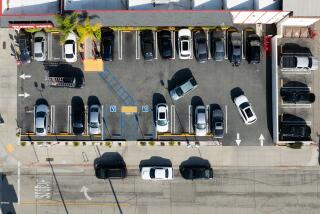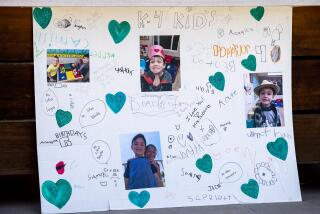A Microcosm of a New Disorder
BAGHDAD — The boy and his donkey wait. Behind them, a man driving a forklift waits too. Farther back, two Humvees with a platoon of tense American soldiers also wait. Next in line are three red buses filled with singing Iraqi communists and a blue van with a black coffin on top and a group of wailing women inside. Everyone waits, though some wait more patiently than others.
The donkey has blinders on. Perhaps it is resigned to its fate: hauling a cart in 115-degree heat, stuck in another jam along with dozens, if not hundreds, of angry truck and taxi drivers and other miscellaneous commuters unlucky enough to plan a trip through the intersection of Rashid Camp Street and Saddam’s Great Bridge Road.
The three-lane-by-two-lane convergence of the streets is a boiling jigsaw puzzle of overheated cars. Men in dishdasha robes or sweat-stained shirts gesture frantically, walking among the stationary vehicles pointed in opposite directions, raising their arms in exasperation, trying to sort it all out.
“Back!” “Stop!” “Go!” “No!” “What are you doing?”
All of the volunteer traffic cops are themselves stranded drivers: They’ve gotten out of their cars and walked to the intersection to try to clear a path through the mess.
“Why do you bother yourself? There is no hope,” a driver in a Mercedes tells one of the volunteers, who is yelling, “Wait!” in fervent Arabic.
This is what it means to drive in Baghdad at peak traffic hours -- roughly 10 in the morning till 2 in the afternoon, when people try to go home to sleep off the heat and the craziness of their occupied city.
On Permanent Break
There are a few traffic officers in Baghdad, but they have a tendency to abandon their posts and seek shelter from the sun at nearby soft drink stands. People driving down Rashid Camp Street on their way across Saddam’s Great Bridge Road are on their own. Getting through this one intersection can become a 30-minute crawl.
It wasn’t always this way.
“That traffic light, it used to work,” says Ishmail Almosuay, a clerk at a machine parts store overlooking the intersection. “People used to respect the signal. If they didn’t, they could be arrested. As you see, there is no electricity, so there is no signal. There is no order, no discipline.”
Any Caltrans engineer who ever wondered what might happen if a city of 5 million people suddenly ceased to have enforceable traffic laws can come to Baghdad for the answer.
Cars routinely cross ripped-up center dividers and drive the wrong way on four-lane highways -- the better to avoid slow traffic on the correct side of the road. Faced with a backup caused by a U.S. military checkpoint up ahead, drivers pull onto the sidewalks as if they were rush-hour express lanes.
They honk at the pedestrians to get out of the way. There isn’t a patrol car in sight to stop them.
“The Americans are closing all the roads. They closed the suspended bridge too,” says 44-year-old Magid Hameed, explaining the sequence of events that brought him to the intersection, where his battered turquoise Renault has stalled on the sidewalk near the useless traffic signal.
When a space in the intersection opens up, he pushes his car onto the street again and tries to make a left turn, causing half a dozen other drivers to scream at him in outrage.
The traffic light hasn’t worked since the U.S. military entered the city. No one in the neighborhood really knows why Baghdad’s new rulers can’t fix it. It becomes one more thing to blame on the Americans.
“It was better for us under the Saddam regime,” 16-year-old Ahmed Tarek says.
“Look at this,” he adds, pointing at a long line of cars waiting to buy gasoline. That line adds to the traffic problem by taking up one of the two lanes of Saddam’s Great Bridge Road, forcing west- and eastbound cars to share a single lane.
“We are the country of oil,” Ahmed observes, “but there is no gasoline.”
Like a lot of things in Iraq these days, the gas shortage doesn’t make any sense. There is, however, a certain logic and pattern behind the apparent chaos at the intersection, though only the people who work there all day can see it.
In the early morning -- rush hour in Los Angeles -- the cars move through here with only the briefest of backups. A driver who heads south on Rashid Camp Street can wait for a lull in the cross traffic and simply plunge across.
A Mess by Noon
After 10, the line of cars heading south gets longer. Gridlock sometimes forces the cars to squeeze through one at a time. By noon, the backup on Rashid Camp is two blocks long.
Inevitably, some of the drivers stuck a hundred yards or so back get out of their cars to find out what’s happening ahead, leaving a passenger at the wheel to inch the vehicle forward.
At the intersection, the less-than-selfless good Samaritans push at the hoods of cars blocking the way, raising their upturned hands in a fingers-touching-thumb gesture that means “patience.” Once their own cars pass through the intersection, they jump back in and drive off. Moments later, other self-appointed traffic cops step forward.
At about 1 p.m., a pair of U.S. soldiers whose Humvee is stuck a block or so away march up to the intersection.
Like everyone else, they are frustrated. The heat and the traffic are bad enough; the fact that American GIs have been attacked and killed in Baghdad in precisely these kinds of crowded urban situations only makes things worse.
A sergeant whose helmet identifies him as “Pressley” yells exactly the same things in English as the Iraqi drivers around him yell in Arabic -- and he appends an expletive to each “Stop!” or “Hold up!” for good measure. When drivers don’t obey, he lifts his M-16 and points it at their cars’ radiators.
After a few minutes, Sgt. Pressley has southbound traffic flowing again. When his Humvee pulls up, he looks around to make sure all of his soldiers are accounted for. “Let’s go,” he says, and the Americans leave. A moment or so later, a southbound Mercedes nearly crashes with a westbound truck. The gridlock is on again.
“You see, the Americans only come here to help their vehicle,” says Almosuay, the clerk. “They don’t care about us. No one cares about us.”
More to Read
Sign up for Essential California
The most important California stories and recommendations in your inbox every morning.
You may occasionally receive promotional content from the Los Angeles Times.











